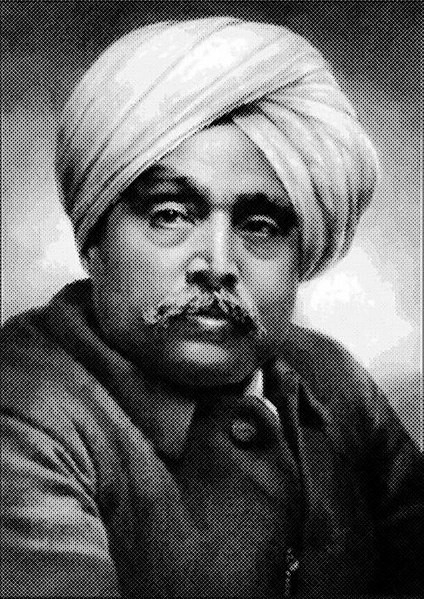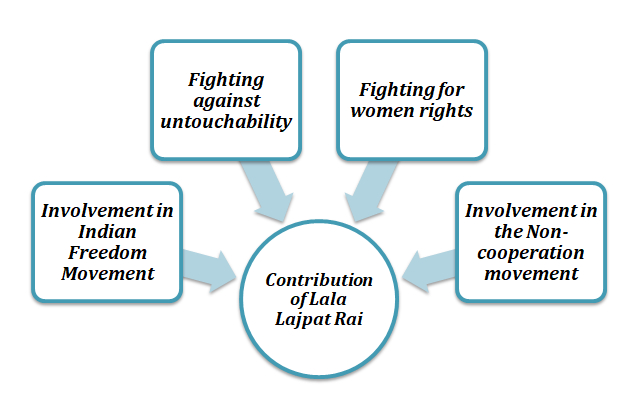

Lala Lajpat Rai was one of the cornerstones in the history of the Indian freedom struggle. His contributions to the Indian freedom movement made him one of the notable cynosures in Indian history. He was later named the Punjab Kesari for his fierce participation in the Indian movement for freedom. He was one of the key members of the Indian National Congress (INC).
During the movement of Hindu supremacy, he was appointed as a leader. After seeing the condition of the poor children he decided to establish many schools for them.
Lala Lajpat Rai was one of the famous authors in the period of independence He was also a well-known freedom fighter. He was born on 28th January 1865 in Dhudike which was located in the district of Punjab. He was considered to be one important member of the Lal- Bal-Pal triumvirates. Not only that, he made various necessary contributions to society among them was the establishment of the Punjab National Bank.

Lala Lajpat Rai
Punjab State Archives, CC BY-SA 4.0
The name of Lala Lajpat Rai’s father was Munshi Radha Krishan Agarwal and his mother’s name was Gulab Devi Agarwal. His father was a government school teacher in many Urdu and Persian schools. His family moved to Rewari in the year 1870. He started his education there only. Later on, his father was appointed as an Urdu teacher. He was influenced by his family toward the Hindu religion.
During the period of his youth, he decided to spread the importance of this religion through various works. Later on, he joined politics and became a member of a very old party known as the Indian National Congress (Moffat, 2020).
He passed Law at a Government College of Punjab in the year 1880. There he met many other freedom fighters like Lala Hans Raj and Pandit Guru Dutt. He was one of the chroniclers of the Arya Gazette in Punjab in the Lahore district. After finishing his educational life in the Lahore district, his family moved to Rohtak in 1884.
Lala Lajpat Rai decided to devote himself to the freedom movement of India. During the year 1914, he left practising law and went to the United Kingdom and in 1917 he travelled to the United States. After joining the Indian National Congress, he was deported to Mandalay and he was mainly trapped in a conspiracy that was planned by the British Government for participating in political unrest that was organized in Punjab. Due to insufficient evidence and lack of proper proof he was declared guilty.

Contribution of Lala Lajpat Rai
In the year 1920, he was elected as a member of the INC in Calcutta. In 1921 he led the movement by creating social servants in the people’s society. Due to this, a non-profitable welfare association was moved to the Delhi headquarters which got proper finalization after the partition movement.
In today’s period also many branches exist in several places in the country. He was strictly against the rule of the poor people being untouchables.
Lala Lajpat Rai was a firm believer in Hinduism and he wanted that most of the Hindu Vedas and Upanishads should be learned by every people in the country. During the first World War, he mainly stayed in the United States but he returned in 1919. After returning from the US he again led the INC during the period of the Non-Cooperation movement in that year only.
He was put in jail from 1921 to 1923 after his release he was again elected as a member of the Legislative Assembly.
Lala Lajpat Rai was a very heavy leader of the Nationalist movement of India. The movement was led by the INC and the Arya Samaj. He wrote many articles and published them with the help of the young generation. After reading his articles many other freedom fighters were inspired and decided to dedicate their own lives to the motherland. He was a founding member of many organizations during the late 19th’ and 20th centuries.
He was the founder of the Laxmi Insurance Company which still now bears his honour. His main wish was to establish a hospital in the name of his mother and after his mother’s death; he created the hospital which is situated in Pakistan. It is now the world’s largest hospital.
The literary works of Lala Lajpat Rai can be named as follows −
Young India: an interpretation
The Arya Samaj: an account
The problem of National Education in India in 1920
Unhappy India in 1928
England’s Debt to India in 1917
Lala Lajpat Rai was one of the most important pioneers in the freedom struggle. Many people come to know about his contributions to the Indian Freedom movement as well as in literature. He was from a middle-class family.
He received his education in Rewari. From childhood only he was a strong believer in Hinduism and gave respect to other religions also. He did not use to believe in the fact of untouchables which were strictly believed by most of the people of the Indian society. His contribution to the freedom struggle was very remarkable. He was also one of the authors who inspired many other freedom fighters through his writings.
Q.1. What was the contribution of Lala Lajpat Rai to the struggles of the untouchables in India?
Ans. Lala Lajpat Rai mainly fought the movement with many lower-caste people. His contributions to the untouchables were one of his notable works as he believed all people are equal and everyone has equal status.
Q.2. What did the followers of Lala Lajpat Rai do in Surat?
Ans. Many of the followers of Lala Lajpat Rai tried to elect him as a member of the presidency of the party in Surat. They were mostly unable to make him eligible for that post due to his involvement in the freedom movements.
Q.3. What contributions did Lala Lajpat Rai make to women empowerment in India?
Ans. Lala Lajpat Rai fought for the equality of Indian women specifically for those who were restricted from being an equal part of society. He led many missions in rural areas to enable people to understand equality in society for women too.